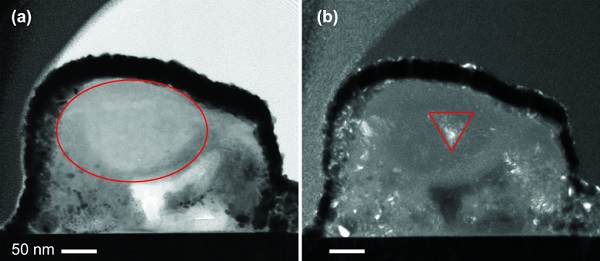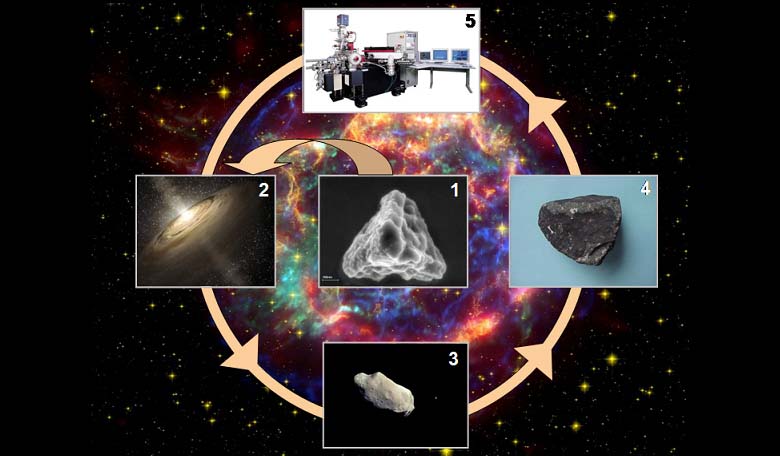Using state-of-the-art instrumentation at the Astromaterials Research and Exploration Science Division at NASA’s Johnson Space Center in Houston, scientists have studied the histories of dust particles that have roamed the Galaxy for millions of years before the sun and planets formed to reveal under what conditions these grains originated from.
The individual silicate grains of stardust, which are smaller than 1/1000 of a millimetre in size, were analysed with a high spatial resolution ion probe known as the NanoSIMS 50L, to determine the abundance ratios of different isotopes of oxygen within the grain. Isotopes are versions of an atom or an element that have the same number of protons, but different numbers of neutrons – the most abundant oxygen atom is 16O, having eight protons and eight neutrons in its nucleus.
In stellar nucleosynthesis, different types of reactions produce oxygen atoms with different numbers of isotopes. For example most 16O is synthesised at the end of the helium fusion process in stars via the triple-alpha reaction, whereas 17O is primarily made by the burning of hydrogen into helium during the carbon-nitrogen-oxygen (CNO) cycle. 18O on the other hand is produced when a nitrogen atom captures a helium atom and is therefore more commonly found in the helium-rich zones of stars. Accordingly the abundance ratios of different isotopes of oxygen are diagnostic of the type of star from which they came.
“About 1 in every 5,000 silicate grains from the meteorites we studied was produced by another star before our Solar System formed. After analyzing millions of silicate grains, we identified bona fide silicate stardust from three major dust producers in the Galaxy: red giant stars, explosive supernovae, and novae,” said the leading author, Dr. Ann Nguyen, Jacobs cosmochemist at NASA’s Johnson Space Center.
“The next step was to determine the chemistry and structure of these grains in order to answer questions such as, under what conditions did these grains form? How different were these conditions in stellar outflows compared to more violent stellar explosions? What types of environments did the grains encounter on their journey to our Solar System?”
To answer these questions co-author of the paper and NASA planetary scientist Lindsay Keller used another powerful instrument, the transmission electron microscope, or TEM to study cross-sections of 9 silicate stardust grains that were a mere ~70 nanometers thick.
“Coordinated analyses of these grains is a powerful approach. The isotopic measurements reveal that these grains originated from very different types of stars. Combining this information with the TEM observations provides us with unique insights into the physical and chemical conditions that existed when the grains formed,” said Keller.
What the research uncovered was that along with a wide range of chemical compositions, many of the silicate grains were amorphous in nature, meaning that they lacked a clearly defined shape – the opposite to a crystalline structure. However silicate crystals were also identified and these were identified at originating within a red giant and likely formed at higher temperatures than the amorphous grains.
 These transmission electron microscope (TEM) images reveal that one interstellar grain consists of a small crystalline enstatite core within a non-crystalline (amorphous) silicate of similar elemental composition. In the TEM image on the right, crystalline materials appear bright and amorphous materials are dark. Image credit: ARES/NASA
These transmission electron microscope (TEM) images reveal that one interstellar grain consists of a small crystalline enstatite core within a non-crystalline (amorphous) silicate of similar elemental composition. In the TEM image on the right, crystalline materials appear bright and amorphous materials are dark. Image credit: ARES/NASA
Grains with the same chemical composition consistent with the mineral enstatite were also analysed (one from a supernova and the other from a red giant star) and these were found to have evidence for radiation processing in space. "The chemical composition of the grains indicates they originally formed as crystals, but these grains later encountered high energy radiation in space sufficient to destroy their crystal structures. Evidence of this radiation exposure is extremely rare in silicate stardust. Most of the stardust grains that we studied seem to have escaped such processing,” said Nguyen.
The team conclude that the grains, selected from a uniquely primitive carbonaceous chondrite from the Sahara (Acfer 094) and the CR chondrite Queen Alexandra Range 99177, formed under a similar range of conditions, as a systematic difference in the chemistries and mineralogies of the silicates were not identified.











